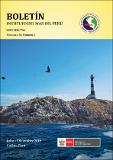Por favor, use este identificador para citar o enlazar este ítem:
https://hdl.handle.net/20.500.12958/3392Registro completo de metadatos
| Campo DC | Valor | Lengua/Idioma |
|---|---|---|
| dc.contributor.author | Aronés Flores, Katia | - |
| dc.contributor.author | Nakazaki, Carmela | - |
| dc.contributor.editor | Instituto del Mar del Perú | - |
| dc.date.accessioned | 2019-12-31T13:35:08Z | - |
| dc.date.available | 2019-12-31T13:35:08Z | - |
| dc.date.issued | 2019 | - |
| dc.identifier.citation | Bol Inst Mar Perú. 34(2) 2019: p. | es_ES |
| dc.identifier.issn | 04587766 | - |
| dc.identifier.uri | https://hdl.handle.net/20.500.12958/3392 | - |
| dc.description.abstract | Durante el otoño del 2015, los biovolúmenes de zooplancton variaron entre 0,1 y 25,0 mL/muestra, los más frecuentes y de menor valor lo hicieron entre 0,1 y 5,0 mL/muestra (54,29%) y los menos frecuentes (5,71%) fueron mayores a 20,1 mL/muestra, localizados principalmente entre Chicama y Salaverry. Las especies Euphausia lamelligera (Hansen); Nyctiphanes simplex (Hansen) y Stylocheiron sp., fueron los eufáusidos más representativos en los estadios caliptopis, furcilia y juveniles. En el ictioplancton se determinaron 32 especies pertenecientes a 44 familias, las más frecuentes y abundantes fueron Engraulidae (33%) y Phosichthyidae (27%). Engraulis ringens (Jenyns) fue la más abundante con valores de 3 a 14.304 huevos/m² y 3 a 975 larvas/m². Los huevos y larvas de Merluccius gayi peruanus (Guichenot) se registraron al sur de Salaverry. | es_ES |
| dc.description.abstract | ABSTRACT: In autumn 2015, zooplankton biovolumes varied between 0.1 and 25.0 mL/ sample, the most frequent and least valuable ones between 0.1 and 5.0 mL/sample (54.29%) and the least frequent ones (5.71%) were greater than 20.1 mL/sample, located mainly between Chicama and Salaverry. The species Euphausia lamelligera (Hansen); Nyctiphanes simplex (Hansen), and Stylocheiron sp., were the most representative euphausiids in the perivitelline, furcilia, and juvenile stages. In ichthyoplankton, a total of 32 species belonging to 44 families were determined, the most frequent and abundant being Engraulidae (33%) and Phosichthyidae (27%). Engraulis ringens (Jenyns) was the most abundant with values of 3 to 14,304 eggs/ m² and 3 to 975 larvae/m². Eggs and larvae of Merluccius gayi peruanus (Guichenot) were recorded south of Salaverry. Keywords: | - |
| dc.language.iso | spa | es_ES |
| dc.publisher | Instituto del Mar del Perú | es_ES |
| dc.relation.ispartofseries | Boletín IMARPE 34(2), 2019; | - |
| dc.rights | info:eu-repo/semantics/openAccess | es_ES |
| dc.rights.uri | https://creativecommons.org/licenses/by/4.0/ | es_ES |
| dc.source | Instituto del Mar del Perú - IMARPE | es_ES |
| dc.source.uri | Repositorio Digital IMARPE | es_ES |
| dc.subject | Ictioplancton | es_ES |
| dc.subject | Eufáusidos | es_ES |
| dc.subject | Costa Peruana | es_ES |
| dc.subject | Anchoveta | es_ES |
| dc.subject | Merluza | es_ES |
| dc.title | Ictioplancton y eufáusidos frente a la costa peruana durante el Otoño 2015 | es_ES |
| dc.title.alternative | Ichthyoplankton and euphausiids off the Peruvian coast in autumn 2015 | es_ES |
| dc.type | info:eu-repo/semantics/article | es_ES |
| Aparece en las colecciones: | Boletín 34(2), 2019 | |
Ficheros en este ítem:
| Fichero | Descripción | Tamaño | Formato | |
|---|---|---|---|---|
| Boletin 34(2)-11.pdf | 1,67 MB | Adobe PDF |  Visualizar/Abrir |
Este ítem está sujeto a una licencia Creative Commons Licencia Creative Commons

